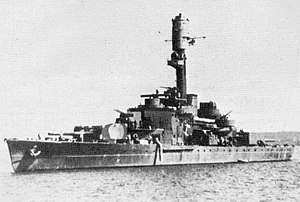Finnish coastal defence ship Ilmarinen

Väinämöinen, sister ship to Ilmarinen
|
|
| History | |
|---|---|
|
|
|
| Name: | Ilmarinen |
| Ordered: | 1927 |
| Builder: | Crichton-Vulcan, Turku |
| Laid down: | September 1929 |
| Launched: | 9 July 1931 |
| Commissioned: | 17 April 1934 |
| Fate: | Sunk by mines on 13 September 1941 |
| General characteristics | |
| Class and type: | Väinämöinen-class coastal defence ship |
| Displacement: | 3,900 t |
| Length: | 93.0 m (305.1 ft) |
| Beam: | 16.864 m (55.33 ft) |
| Draught: | 4.5 m (15 ft) |
| Propulsion: |
|
| Speed: | 14.5 knots (26.9 km/h; 16.7 mph) |
| Range: | 700 nmi (1,300 km; 810 mi) |
| Complement: | 403 (11 September 1941) |
| Armament: |
|
Ilmarinen was a Finnish Navy Panssarilaiva ("Armored ship"; a coastal defence ship by British classification). The unit was constructed at the Crichton-Vulcan shipyard in Turku, Finland, and named after the mythological hero Ilmarinen from the Finnish national epic, the Kalevala. Ilmarinen was the flagship of the Navy from 1 May 1933 until her demise on 13 September 1941.
During the early inter-war period the Finnish Navy consisted of some 30 ex-Russian vessels, most of them taken as war-trophies following the civil war. Never ideal types for the navy's needs, they were generally old and in poor condition. In 1925, a tragic incident highlighted the sorry state of the navy. An old torpedo boat was lost in a fierce storm, taking with her the entire crew of 53. A heated debate started, and intensive lobbying led to the adoption of a new Finnish Navy Act in 1927.
Prior to World War II, the fleet renewal program led to the acquisition or construction of five submarines, four torpedo boats, and two coastal defense ships. Among the last of their kind, Väinämöinen and Ilmarinen were two of the most concentrated naval artillery units ever built. They were designed by the Dutch company NV Ingenieurskantoor voor Scheepsbouw (a front for German interests circumventing the Treaty of Versailles), and were optimized for operations in the archipelagos of the Baltic Sea. Their open sea performance was de-emphasized in order to give the vessels their shallow draft and super-compact design.
Coastal defence ships were particularly popular in the Nordic countries, and began serving in the navies of Denmark, Sweden and Norway early in the 20th century. These vessels typically had heavy armament and good armor protection, but were relatively slow. Their sizes were around 4,000 tons, main armament consisted of guns between 210 and 240 mm (8 and 9 in), the armor corresponded to that of armoured cruisers, and speeds were between 15 and 18 knots (28 and 33 km/h; 17 and 21 mph). A coastal defence ship was somewhere between a cruiser and a monitor: slower than a cruiser but better armed, faster than a monitor, but with smaller guns. The coastal defence ships also varied among themselves; some of them were closer to cruisers, and others, such as the Finnish ones, were closer to monitors.
...
Wikipedia
